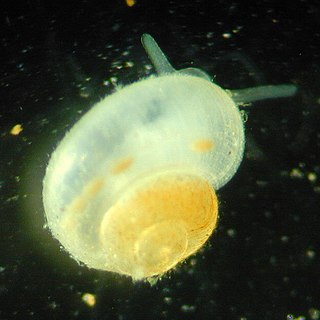Antrorbis breweri, common name Manitou cavesnail, is a species of freshwater snail with gills and an operculum, an aquatic gastropod mollusk in the family Lithoglyphidae.

The Tumbling Creek cavesnail is a species of freshwater cave snail with gills and an operculum, an aquatic gastropod mollusk in the family Amnicolidae.
The Badwater snail is a species of small salt marsh snail endemic to the Badwater Basin in Death Valley. It is found only at low elevations near spring sources, and only in regions with relatively low precipitation. It is capable of living completely submerged in the spring water.

The cobble elimia, scientific name Elimia vanuxemiana, is a species of freshwater snails, aquatic gilled gastropod molluscs with an operculum in the family Pleuroceridae. This species is endemic to Alabama in the United States.
Epioblasma lenior, the narrow catspaw or Stone's pearly mussel, was a species of freshwater mussel, an aquatic bivalve mollusk in the family Unionidae, the river mussels.
The forkshell or Lewis pearly mussel, scientific name Epioblasma lewisii, was a species of freshwater mussel, an aquatic bivalve mollusk in the family Unionidae, the river mussels.
Fontigens is a genus of minute freshwater snails with an operculum, aquatic gastropod molluscs or micromolluscs in the family Fontigentidae.

Leptoxis ampla, common name the round rocksnail, is a species of freshwater snail with a gill and an operculum, an aquatic gastropod mollusc in the family Pleuroceridae.
The bigmouth rocksnail, scientific name †Leptoxis occultata, was a species of freshwater snail with a gill and an operculum, an aquatic gastropod mollusc in the family Pleuroceridae. This species was endemic to Alabama in the United States. It is now extinct.

The painted rocksnail is a species of freshwater snail with a gill and an operculum, an aquatic gastropod mollusc in the family Pleuroceridae.
Pleurobema stabile, the Coosa pigtoe, is a species of freshwater mussel, an aquatic bivalve mollusk in the family Unionidae, the river mussels.
The reverse pebblesnail, scientific name Somatogyrus alcoviensis, is a species of small freshwater snail with a gill and an operculum, an aquatic gastropod mollusc in the family Hydrobiidae.
The thick-lipped pebblesnail, scientific name Somatogyrus crassilabris, was a species of freshwater snail with an operculum, an aquatic gastropod mollusc in the family Lithoglyphidae. This species was endemic to Baxter County, Arkansas in the United States. Its natural habitat was the north fork of the White River. It is now extinct.
The channeled pebblesnail, scientific name Somatogyrus wheeleri, was a species of very small freshwater and brackish water snails that have an operculum, aquatic gastropod mollusks in the family Lithoglyphidae.

Lirceus is a genus of isopod crustaceans in the family Asellidae that live in southern Canada and the eastern United States as far west as the Great Plains. Of the 15 species in the genus, two are listed as either endangered (EN) or vulnerable (VU) on the IUCN Red List.
Fontigens aldrichi, common name the Missouri amnicola, is a species of freshwater snail, an aquatic gastropod mollusk in the family Fontigentidae.

Amnicola dalli, common name the peninsula amnicola, is a species of freshwater snail with an operculum, an aquatic gastropod mollusk in the family Amnicolidae.

Vitta virginea, the virgin nerite, is a species of sea snail, a marine gastropod mollusk in the family Neritidae.








